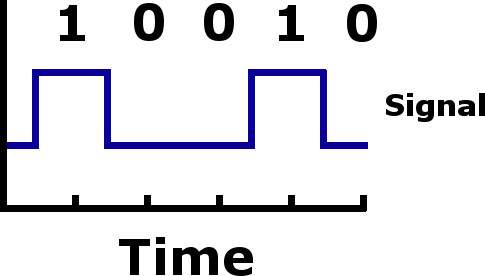2. Network Interface Controller
The Network Interface Controller (also known as an NIC or formerly, as a Network Interface Card) converts the data produced by a computer into a format that can travel along a network connection.
CPUs understand binary, so that is the internal language of a computer.
Binary numbers are made of strings of 0s and 1s. But when you need to transmit a binary number across a network, what does that number physically look like? The answer is: it depends!
The only important factor to a computer is that it is able to tell a 1 from a 0 with absolute certainty. What is being measured, depends on the network.

The signal in the above diagram could be electricity, it could be light, or it could be semaphore flags being raised and lowered. The only thing that matters is that when the strength of the signal is periodically checked, it's possible to tell between one value and the other.
It is the job of the network interface controller to convert the binary number (diagram above) to the correct, corresponding signal (electricity for ethernet cables, infra-red light for fibre-optic cables, radio waves for WiFi).
The computer on the other end of the network has its own NIC that will convert the signals that it receives back into binary.
Challenge see if you can find out one extra fact on this topic that we haven't already told you
Click on this link: What is a network interface controller card
